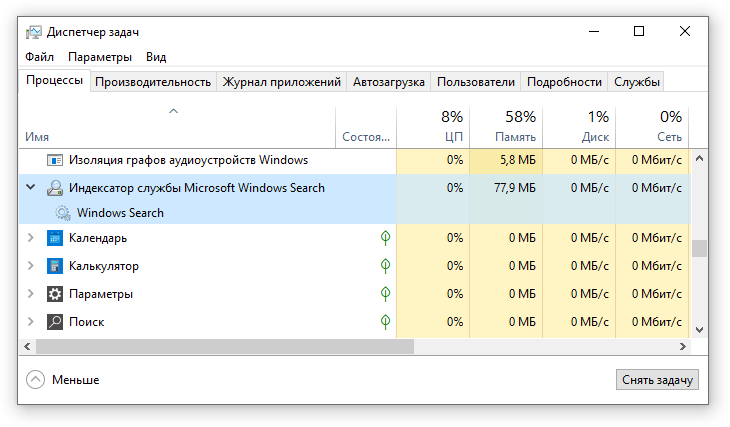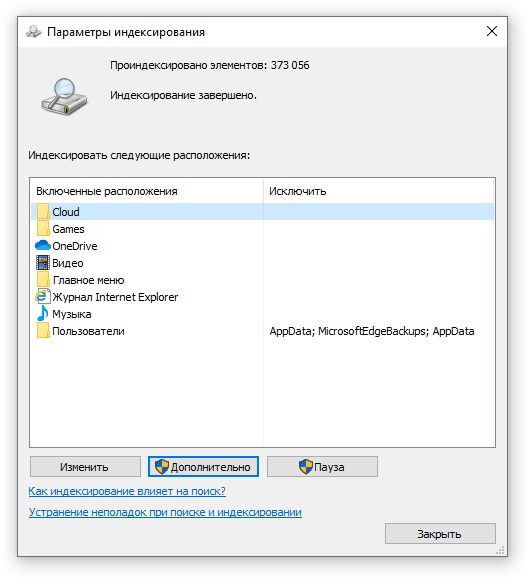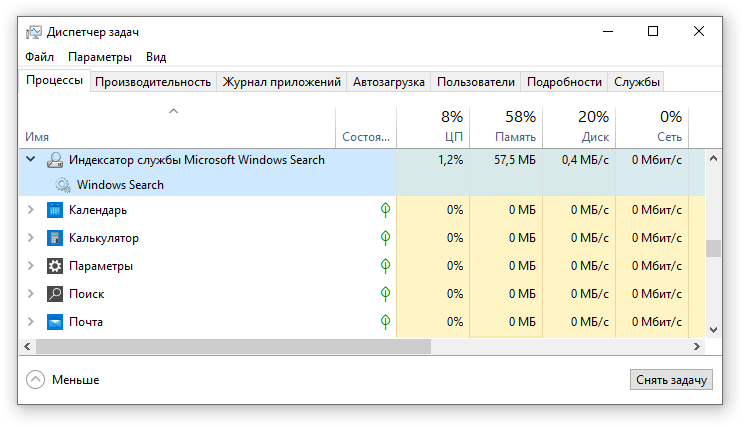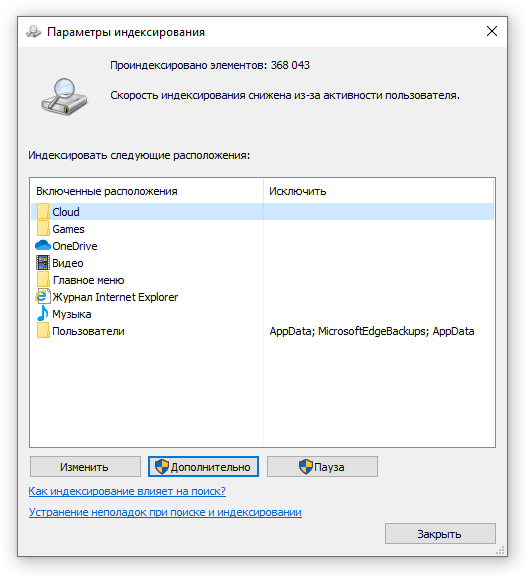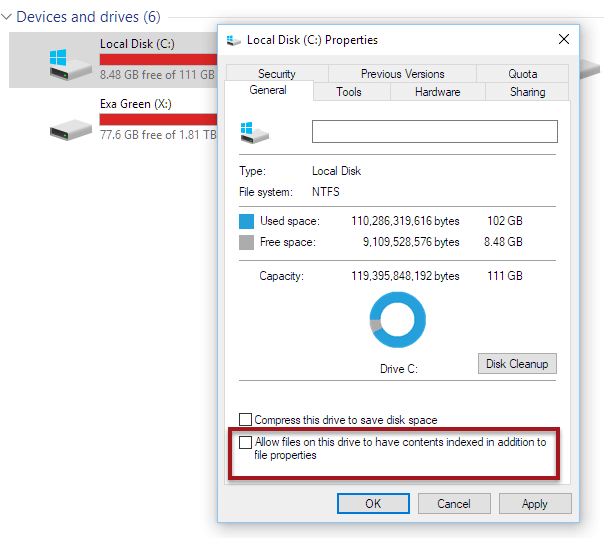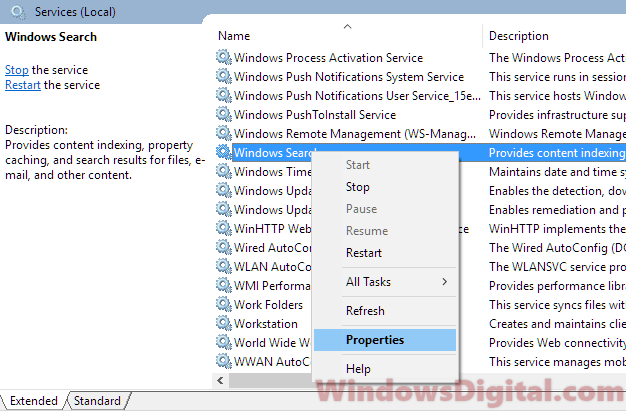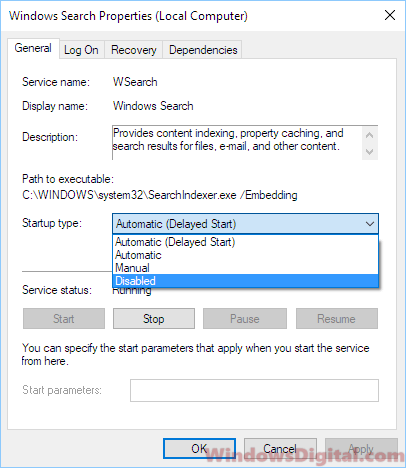Служба Windows Search отвечает за поиск файлов и папок на устройстве. Она способна искать данные не только по наименованию файлов, но и по содержанию этих файлов (метаданным, свойствам и т.д.). Например, поиск по содержанию файлов по умолчанию активирован для текстовых и офисных документов (txt, doc, docx, xls, xlsx, pdf).
На компьютере может быть очень много файлов и папок. Чтобы поиск по устройству не занимал много времени, служба Windows Search использует индексацию файлов. Процесс индексирования представляет собой чтение диска с данными и запись информации о просканированных файлах в базу данных. Индексирование осуществляется в фоновом режиме. Когда вы сохраните новый документ в индексированном расположении, служба Windows Search проиндексирует его и сохранит собранную информацию о нём в своей базе.
Индексатор службы Microsoft Windows Search грузит процессор?
Обычно индексатор службы Microsoft Windows Search не грузит процессор. В нашем случае, когда все файлы проиндексированы, нагрузка на центральный процессор составляет 0%, а объём используемой оперативной памяти составляет порядка 80МБ.
-
На скриншоте видно, что Индексатор службы Microsoft Windows Search в Windows 10 не нагружает процессор, так как все файлы проиндексированы. -
Поэтому, если на вашем устройстве индексатор службы Microsoft Windows Search грузит процессор, это означает, что в настоящее время идёт индексирование файлов. Если вы активно пользуетесь устройством, нажимаете на клавиши клавиатуры, водите мышкой, служба Windows Search замедляет скорость сканирования. В нашем случае при сниженной скорости индексирования нагрузка на процессор составляет 0,6-1,2%.
-
На скриншоте видно увеличение нагрузки на процессор, так как идёт индексирование новых файлов (при сниженной скорости сканирования) -
Конечно, нагрузка будет больше, если процессор относительно старый и имеет одно-два логических ядра. Поэтому приведённые значения нагрузки индексатора службы Microsoft Windows Search на процессор следует считать условными.
Как можно уменьшить нагрузку службы Microsoft Windows Search на процессор?
Определяем папки, которые служба поиска должна индексировать
- Найдите и запустите «Параметры индексирования» в классическом варианте Панели управления.
Как открыть классическую Панель управления?
Несколько простых способов в отдельной статье
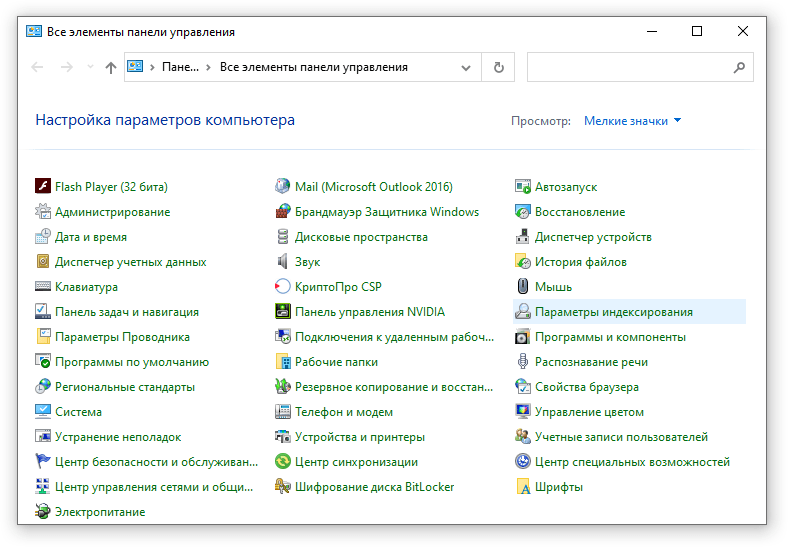
- В открывшемся окне нажмите кнопку «Изменить».
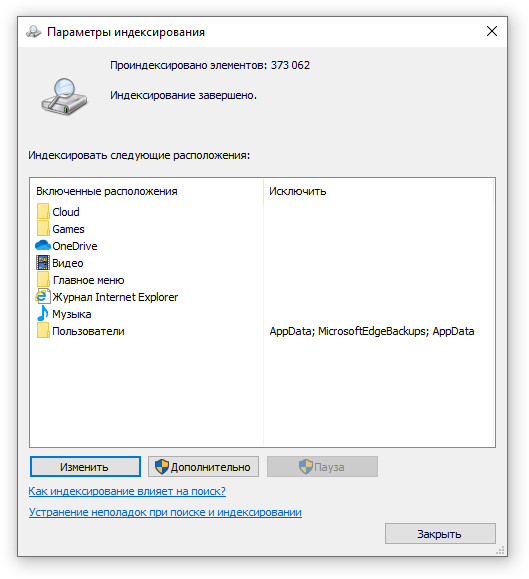
- Отметьте галочками папки или диски, которые вы хотите индексировать в фоновом режиме. Оставьте пустым квадрат, чтобы не индексировать папку или диск. После выбора индексируемых расположений нажмите кнопку «ОК».
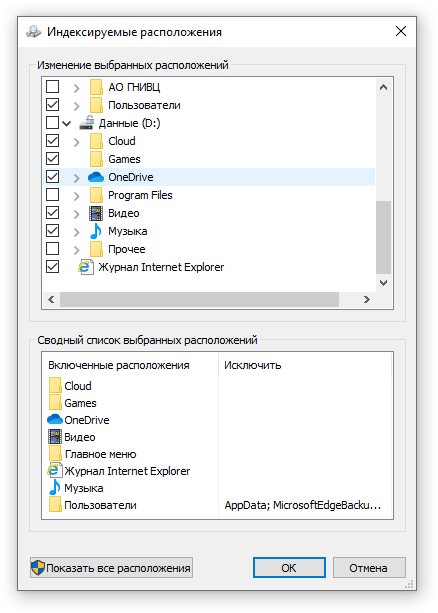
Уменьшив количество папок и дисков в окне «Индексируемые расположения», вы сможете сократить нагрузку индексатора службы Microsoft Windows Search на процессор. Но имейте в виду, что поиск в исключенных расположениях будет долгим. А в случае использования кнопки поиска в панели задач поиск в неиндексированных расположениях осуществляться не будет. Поэтому не старайтесь исключать все папки. Оставьте папки, в которых вы часто используете функцию поиска.
Устанавливаем классический режим поиска
В Windows 10 предусмотрено 2 режима поиска: классический и расширенный. При классическом режиме поиск осуществляется только в библиотеках пользователя и на рабочем столе. Расширенный режим позволяет искать файлы по всему компьютеру, за исключением системных папок. Расширенный режим, как предупреждает операционная система, может снизить уровень заряда и увеличить нагрузку на центральный процессор. Особенно это актуально для владельцев ноутбуков, которым важно, чтобы их устройство проработало в автономном режиме как можно дольше.
- Перейдите в новые «Параметры Windows» (нажмите на клавиатуре кнопку с логотипом Windows + I ).
- Нажмите на раздел «Поиск».
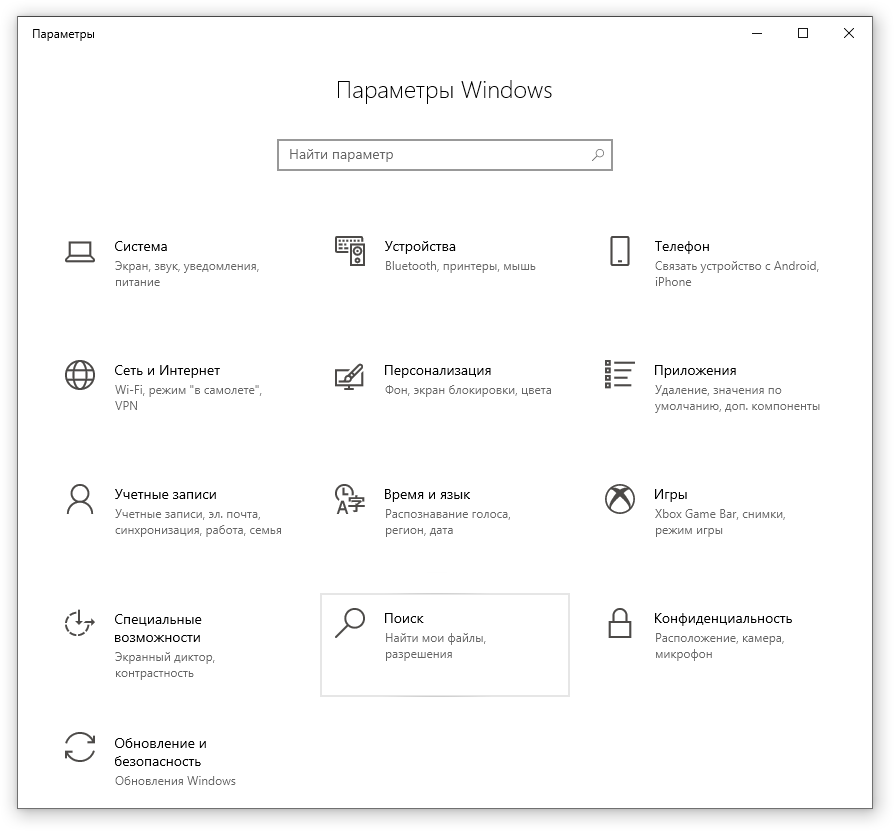
- В левом боковом меню нажмите на «Поиск в Windows».
- Прокрутите список настроек и выберите параметр «Классический стиль».
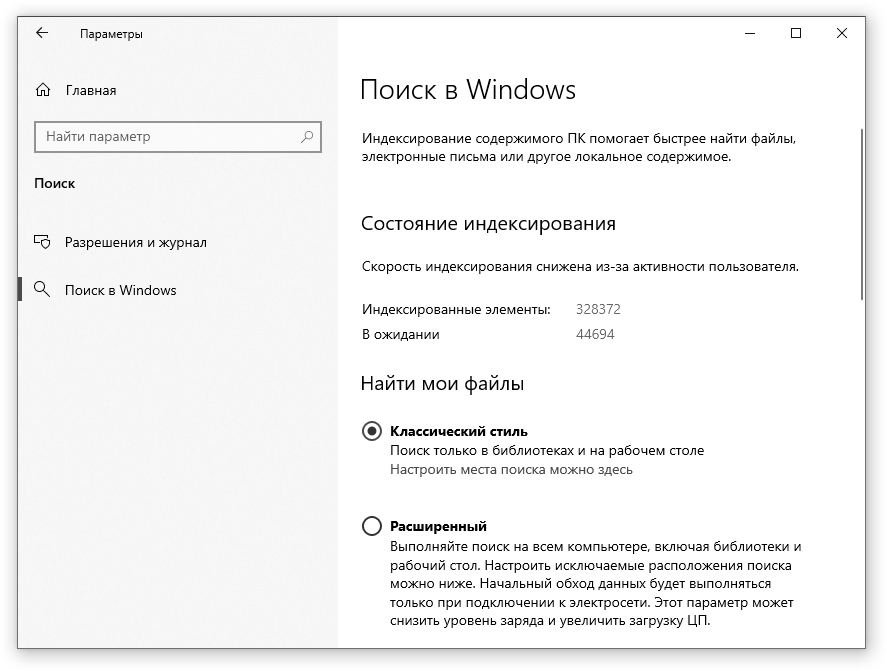
Активируем привязку производительности индексатора к параметрам питания устройства
Изменять режим производительности индексатора стало возможным с момента появления Windows 10 версии 2004 (майское обновление 2020 года). Если включить параметр «Использовать параметры режима питания устройства», служба Windows Search будет оценивать, запущен ли на компьютере режим энергосбережения, пониженного электропотребления или игровой процесс. Если да, то служба поиска приостановит индексацию в фоновом режиме.
Также при включении производительности индексатора служба поиска приостановит индексацию файлов в фоновом режиме, если загрузка центрального процессора превысит 80% или загрузка жесткого диска поднимется свыше 70%.
- Перейдите в новые «Параметры Windows» (нажмите на клавиатуре кнопку с логотипом Windows + I ).
- Нажмите на раздел «Поиск».

- В левом боковом меню нажмите на «Поиск в Windows».
- Прокрутите список настроек и включите параметр «Использовать параметры режима питания устройства».
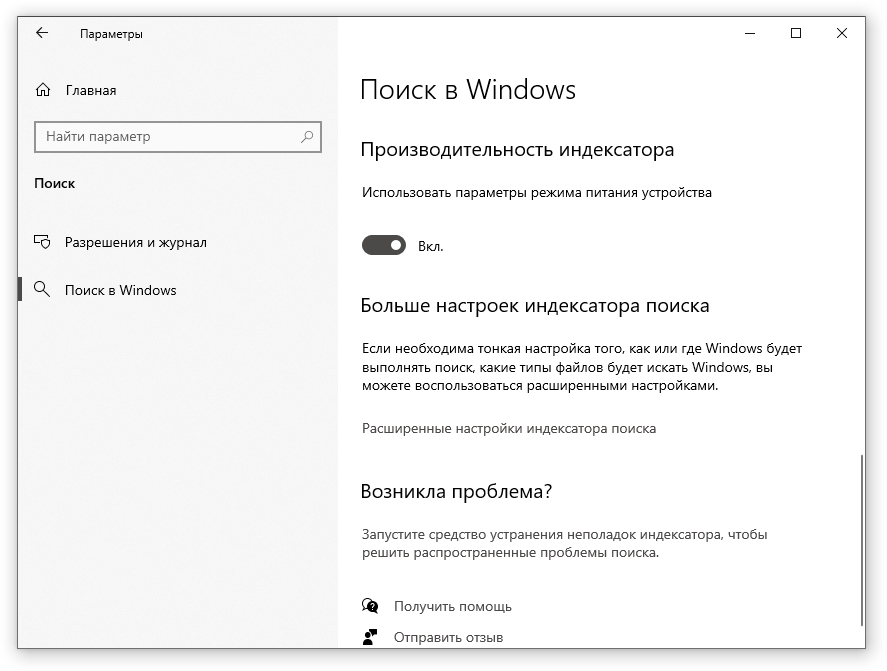
Отключаем службу Windows Search
Отключая службу Windows Search, вы отключите индексирование папок и файлов в фоновом режиме.
Вы сможете осуществлять поиск по устройству, но он будет медленным.
- Запустите приложение «Выполнить» (нажмите на клавиатуре кнопку с логотипом Windows + R ).
- Наберите текст
services.mscи нажмите кнопку «ОК».
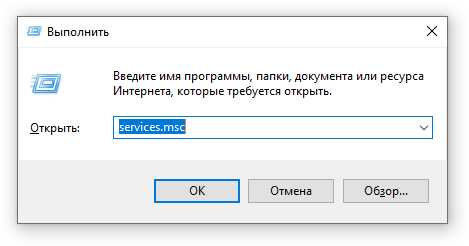
- В открывшемся окне найдите службу Windows Search.
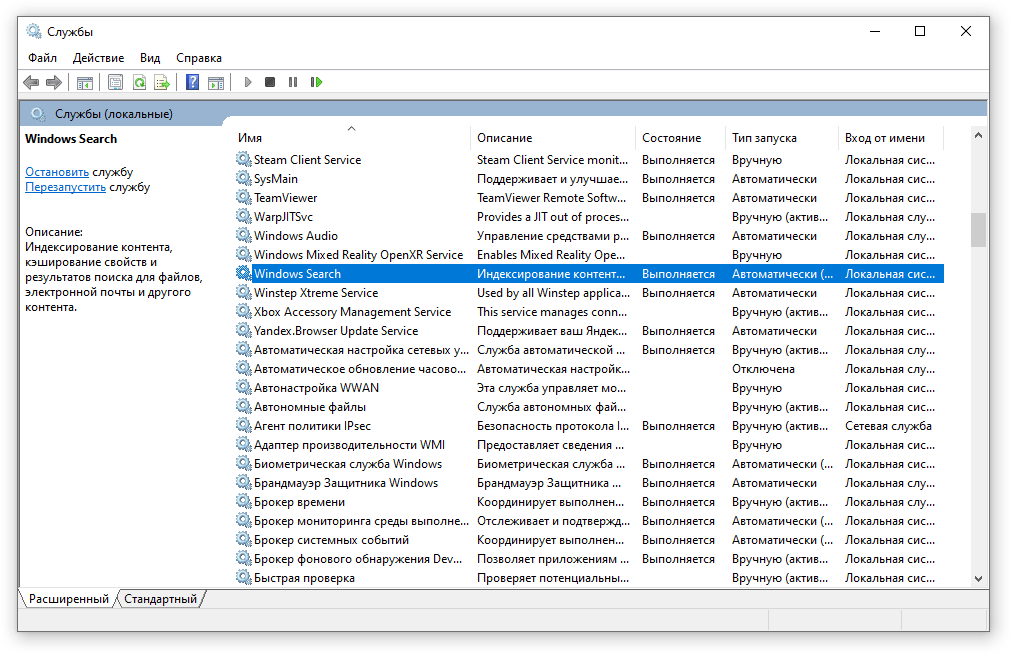
- Дважды нажмите на строку службы «Windows Search». Откроется окно с настройками.
- Выберите тип запуска «Отключена».
- Нажмите кнопку «Остановить», чтобы завершить активный процесс выполнения службы Windows Search.
- Нажмите кнопку «ОК», чтобы сохранить настройки службы.
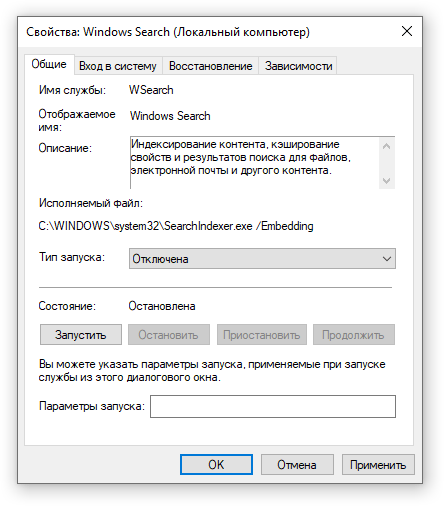
А как у вас работает служба поиска в Windows? Испытываете ли вы проблемы при ее работе в фоновом режиме?
Расскажите о своем опыте в комментариях 😉
Microsoft Windows Search Indexer, or searchindexer.exe, is a crucial process that powers Windows Search. It indexes the files and folders on your computer and, given its nature, consumes lots of CPU at sporadic intervals. However, if CPU usage remains high for prolonged periods, it may indicate an underlying problem that needs to be addressed.
In this tutorial, we’ll show you how to tackle high CPU and disk usage caused by the Windows Search Indexer with various suggestions and solutions for Windows 10 and 11.

Restart Windows Search Service
It’s best to begin by restarting Windows Search on your computer. That should resolve minor technical issues and reduce high CPU usage caused by the searchindexer.exe process. To do that:
- Right-click the Start button and select Run. Or, press Windows + R.
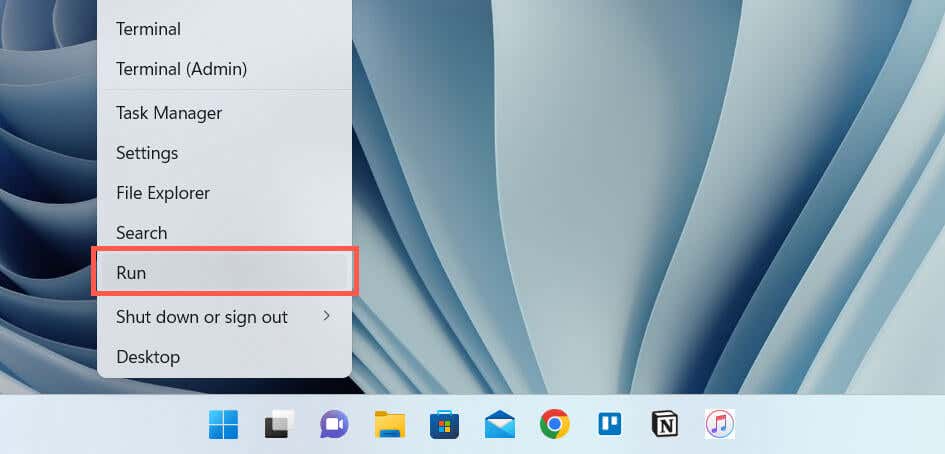
- Type services.msc into the Run Box’s Open field and select OK.

- Right-click the service labeled Windows Search and select Restart.
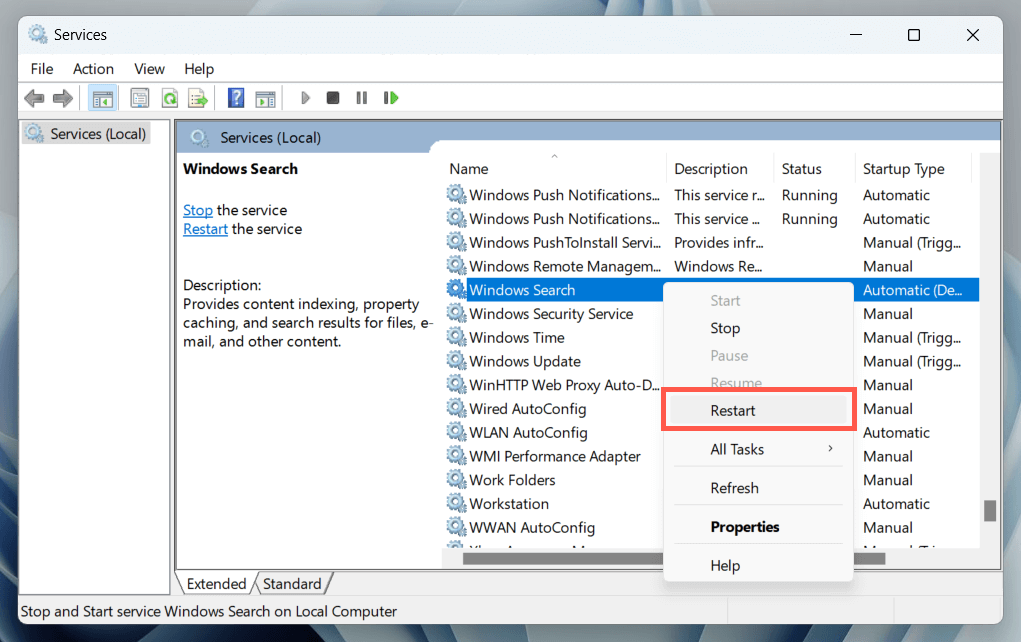
Optionally, double-click Windows Search and ensure that Startup type is set to Automatic (Delayed Start).
Restart Your PC
A PC reboot clears out additional software-related anomalies that interfere with system-related processes. Save your work, open the Start menu, and select Power > Restart. If that makes no difference, move on with the rest of the fixes.
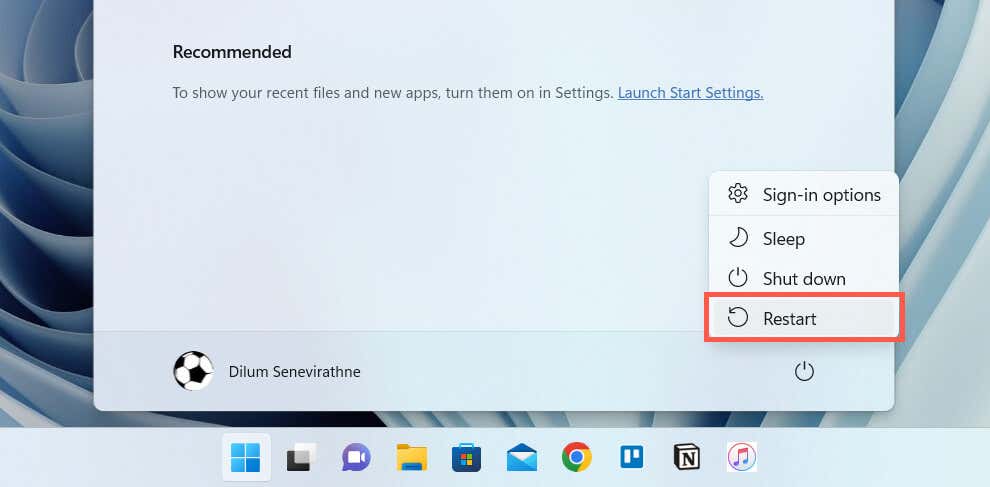
Run Search and Indexing Troubleshooter
Windows 11 and 10 have a built-in troubleshooter that helps diagnose and fix issues related to Windows Search. To run it:
- Right-click the Start button and select Settings.

- Go to System > Troubleshoot.
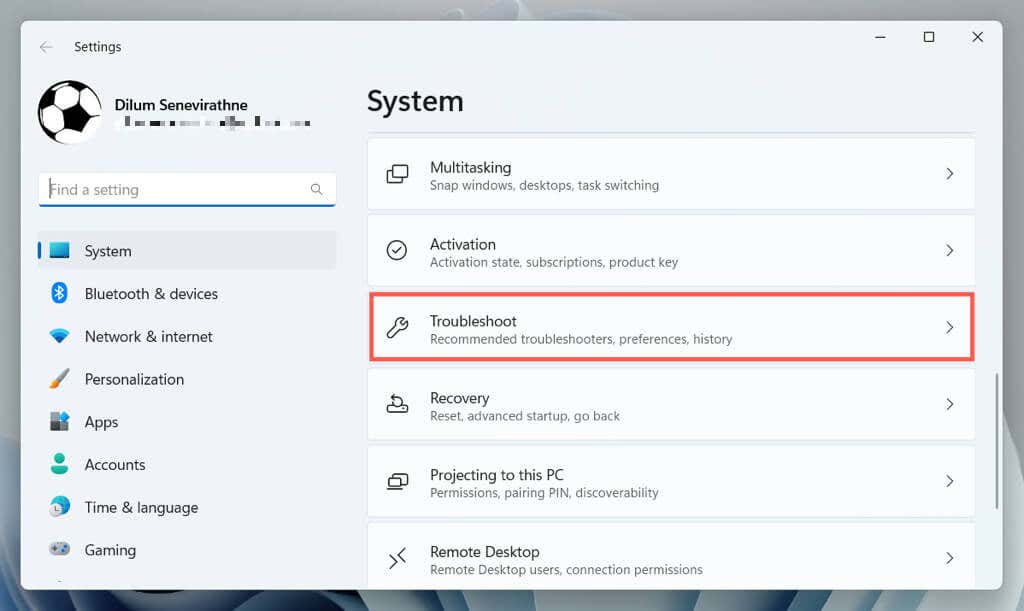
- Select Other troubleshooters/Additional troubleshooters.
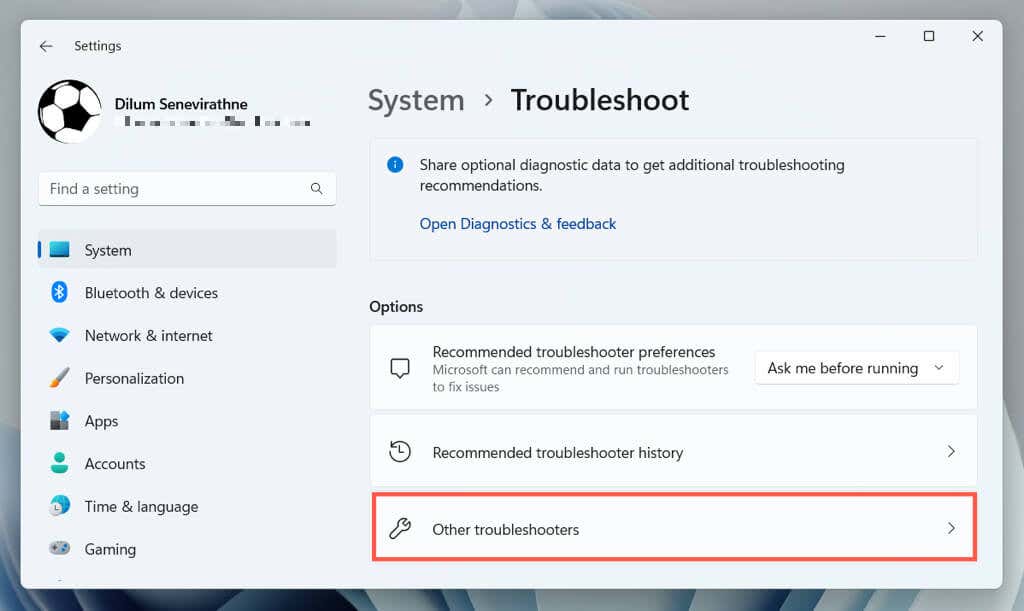
- Select Run next to Search and Indexing.
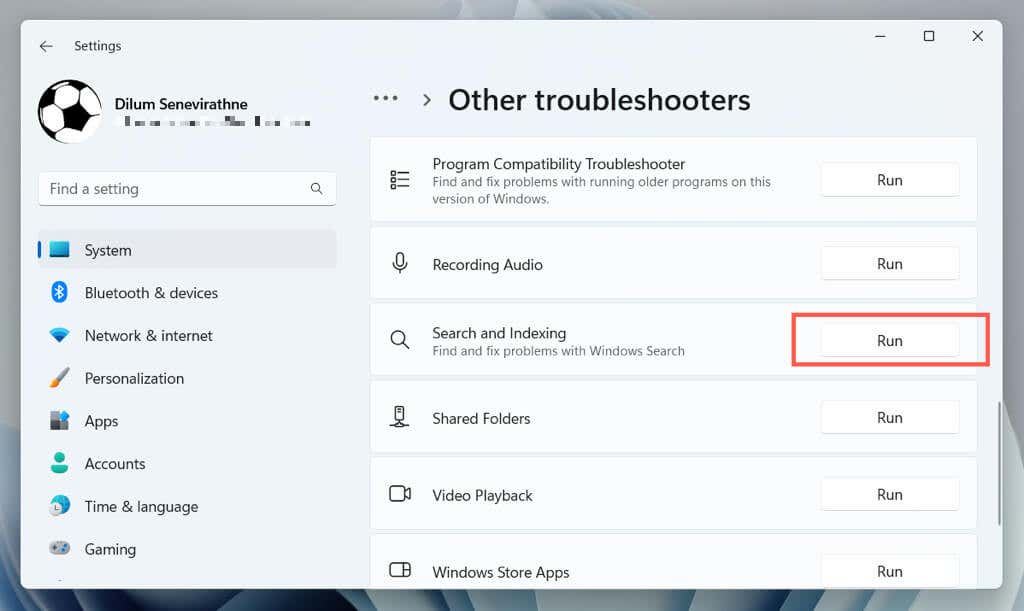
- Follow the onscreen prompts to fix issues with Windows Search.
Rebuild Index
Corruption issues within the Windows Search index often lead to erratic behavior with related processes. Use the Control Panel‘s Indexing Options console to rebuild the index from scratch.
Note: Rebuilding the search index takes time and causes high CPU and HDD/SSD usage for the duration of the procedure.
- Open a Run box, type control.exe srchadmin.dll, and select OK.
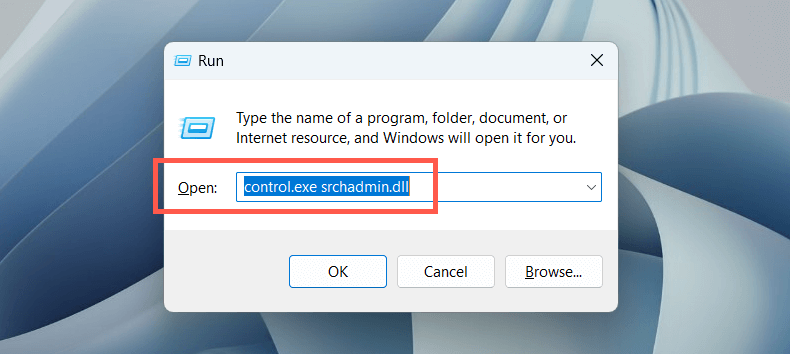
- Select the Advanced button at the bottom of the Indexing Options window.
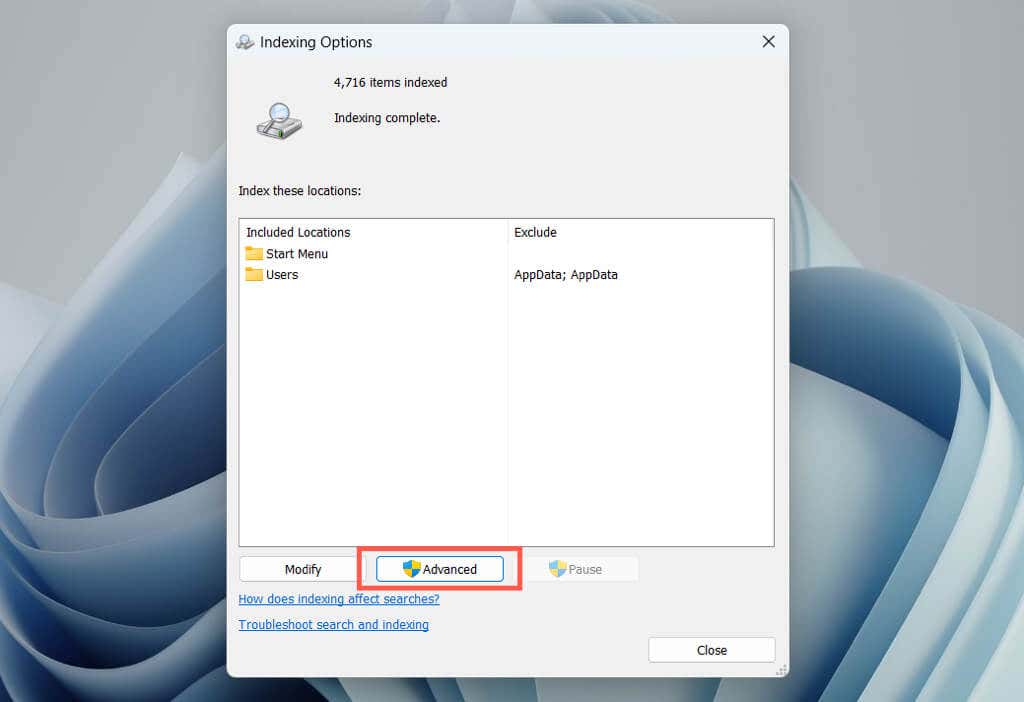
- Select Rebuild.
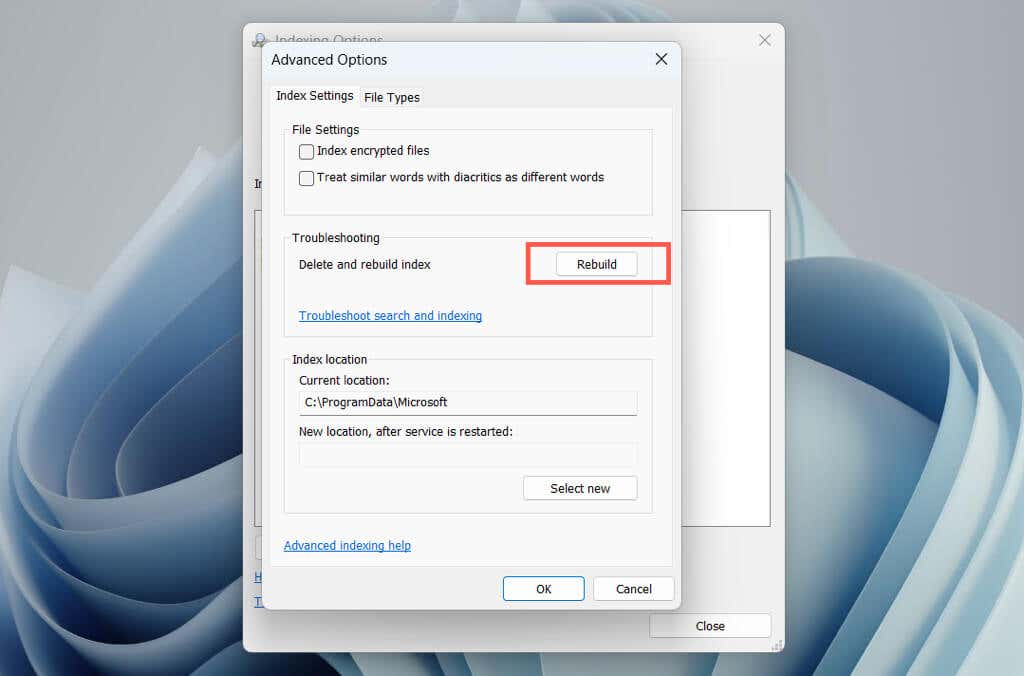
Note: Removing locations you don’t want to include within Windows Search can lessen the load on the searchindexer.exe process. Select the Modify button on the Indexing Options console and uncheck the indexed locations you wish to exclude.
Update Windows
Keeping your Windows operating system up to date with the latest patches and updates can help resolve high CPU usage issues with the Windows Search Indexer process. This also helps improve system performance, security, and stability.
To update Windows, open the Settings app, select Windows Update, and select Check for updates. If there are pending updates, choose Download and install.
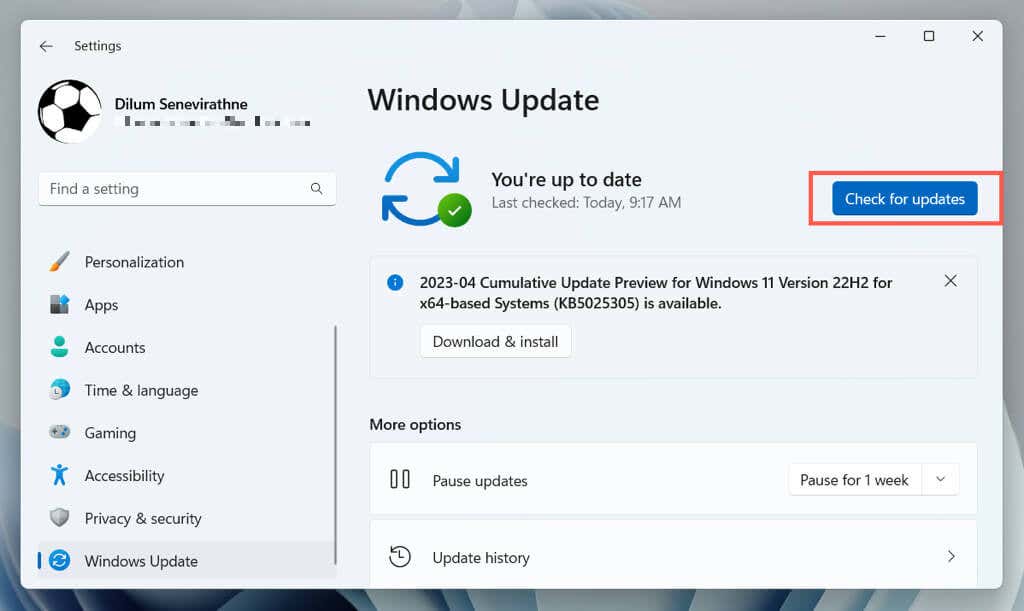
Run an SFC Scan
The System File Checker (SFC) is a command line tool that can help fix system file corruption issues causing the Windows Search Indexer to malfunction. You can run it via an elevated Windows PowerShell or Command Prompt console. Here’s how:
- Right-click the Start menu and select Windows PowerShell/Terminal (Admin). Or, type cmd into the Start menu and choose Run as administrator.
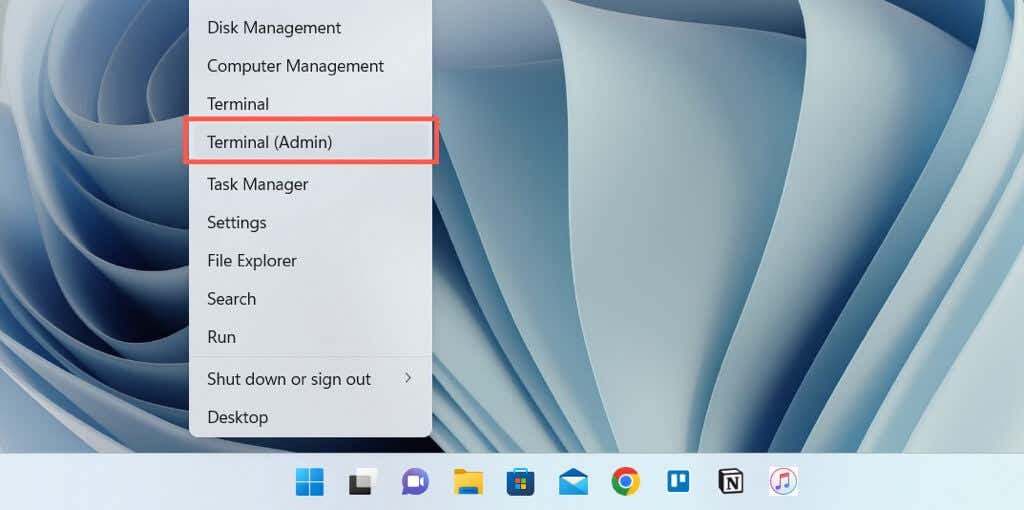
- Run the following command:
sfc /scannow
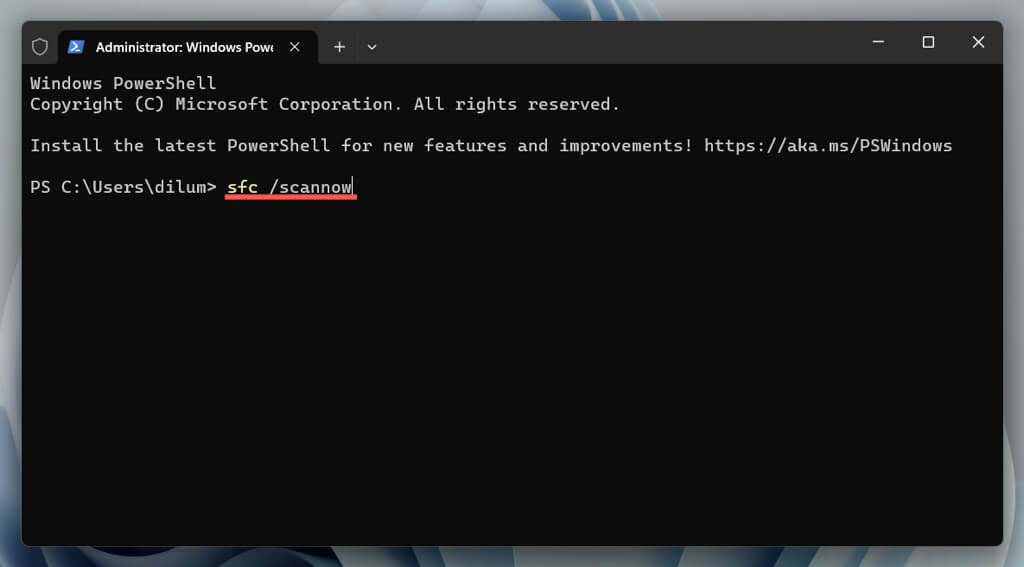
- Wait until the System File Checker scans for and fixes Windows.
Run DISM Tool to Fix Windows
Next, run the DISM (Deployment Image Servicing and Management) tool to resolve issues with operating system stability. Just re-open an elevated Windows PowerShell or Command Prompt console and execute the following command:
DISM.exe /Online /Cleanup-Image /Restorehealth
Perform a Clean Boot
Clean booting Windows helps you identify third-party applications or services causing conflicts with the Windows Search Indexer. To do that:
- Open a Run box, type msconfig, and select OK.
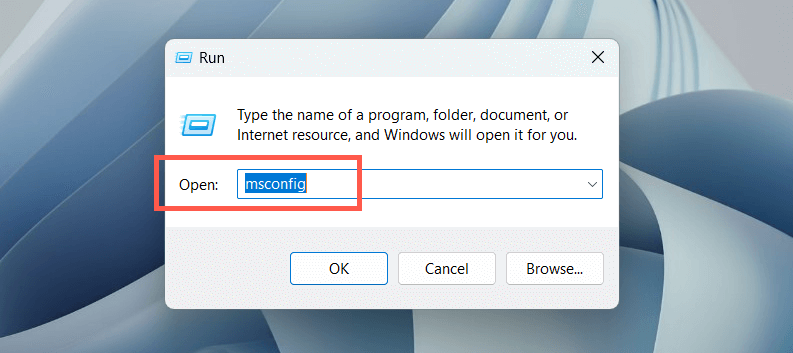
- Switch to the Services tab, select Hide all Microsoft services, and choose Disable all.
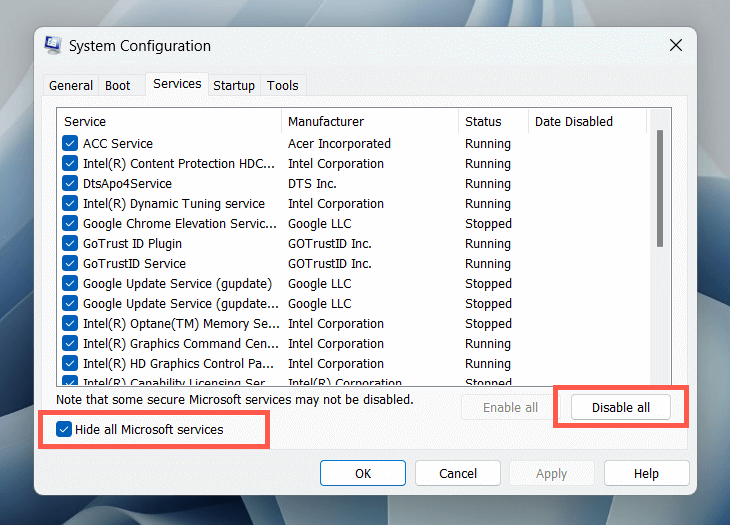
- Restart your computer. If the Microsoft Windows Search Indexer’s high CPU usage stops becoming an issue, re-enable the disabled services individually or in batches to identify the conflicting item.
Additionally, open the Task Manager, disable any non-Microsoft login items from the Startup tab, and check if that helps.
Check for Malware
Malware can hijack the Windows Search Indexer and result in high CPU usage. Run a full system scan to detect and remove malicious software from your system. To do that:
- Open the Start menu, type Windows Security into the search box, and press Enter.
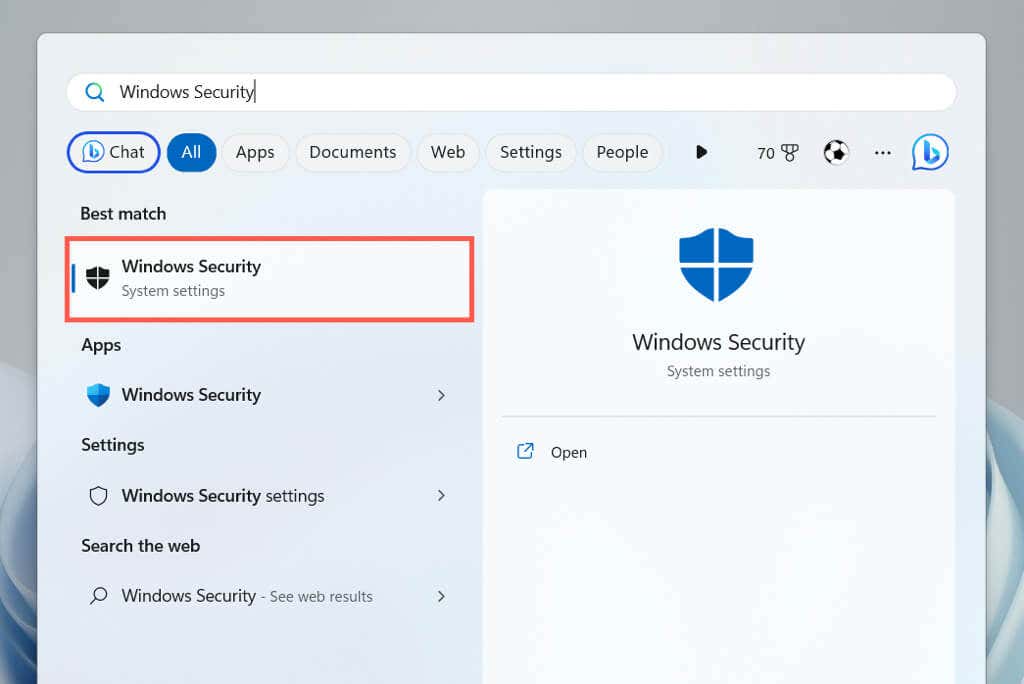
- Select Virus & threat protection.
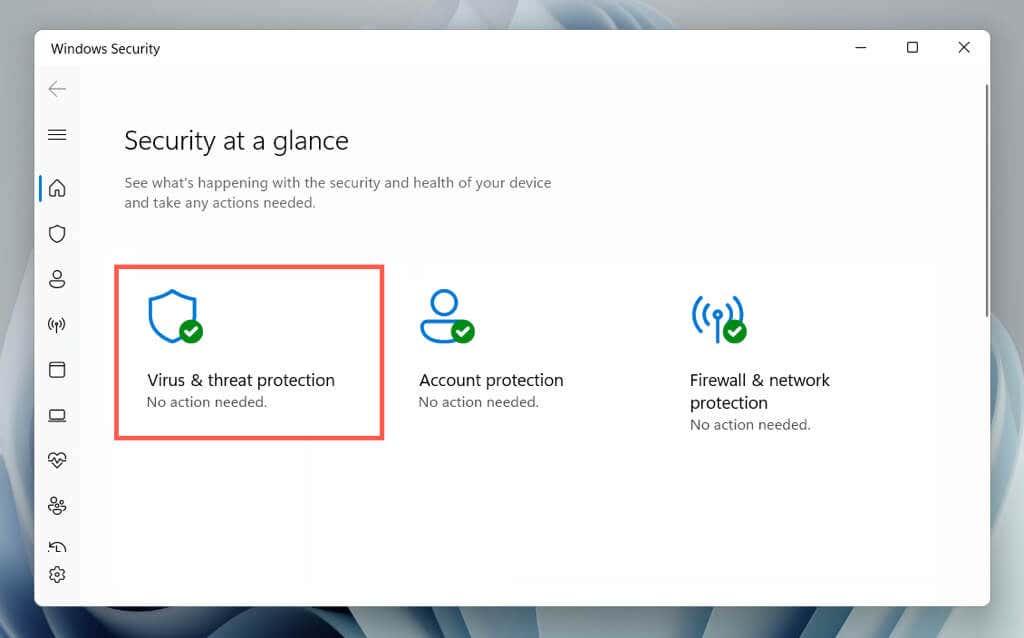
- Select Scan options.
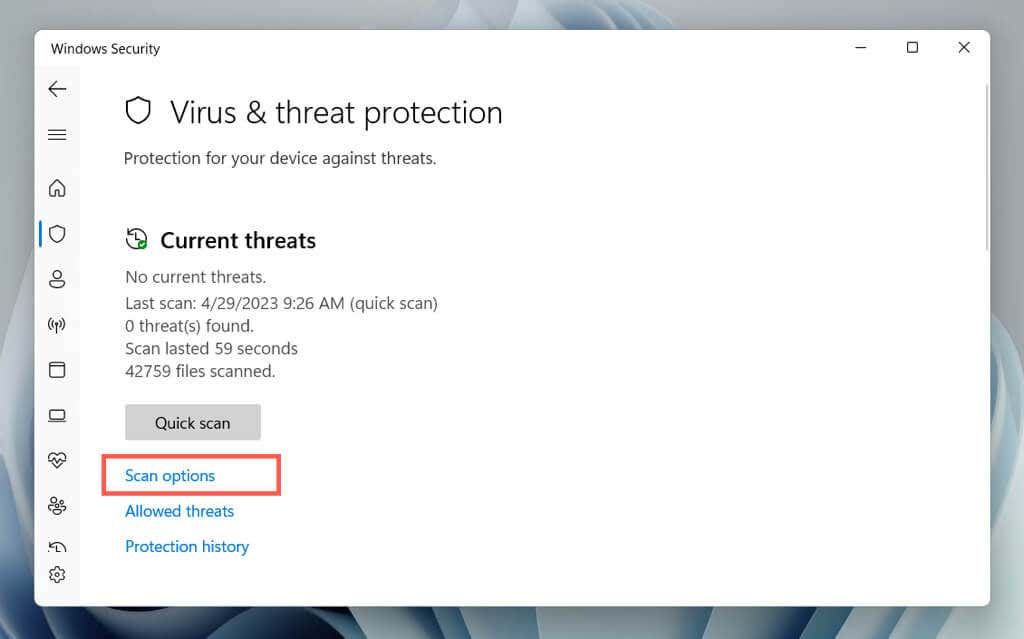
- Select the radio button next to Full scan and choose Scan now.
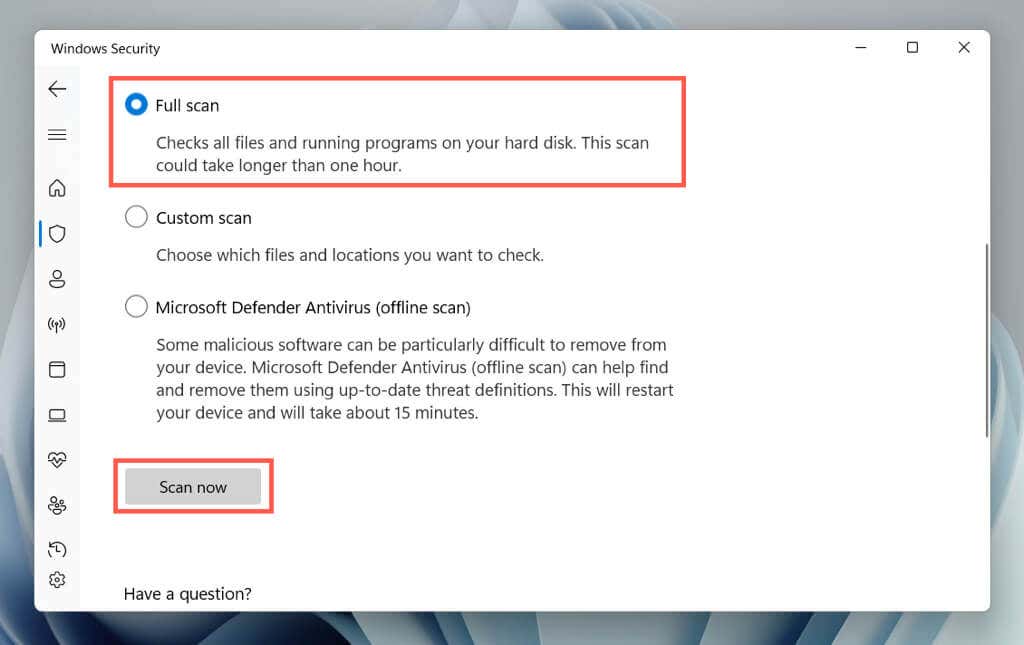
- Wait until Windows Security scans your computer for malware.
You can follow that up with a Microsoft Defender Antivirus (Offline scan), which scans your computer thoroughly for hidden threats. You can also use third-party anti-virus programs to deal with stubborn malware.
Factory Reset Windows
If none of the above methods work, consider factory resetting your PC. This will wipe all data from your computer, return the operating system to its original state, and resolve severe underlying issues with the Windows Search Indexer. Before proceeding, make sure to back up all important files and documents.
To initiate a factory reset, open the Settings app and go to System > Recovery > Reset PC. For comprehensive step-by-step instructions, check our guides to resetting Windows 11 and 10 to factory defaults.
Related Posts
- How to Fix a “This file does not have an app associated with it” Error on Windows
- How to Fix an Update Error 0x800705b4 on Windows
- How to Resolve “A JavaScript error occured in the main process” Error on Windows
- How to Fix the Network Discovery Is Turned Off Error on Windows
- How to Change Folder Icons in Windows
When you open the Task Manager in Windows 10 or Windows 11, you will usually see a process called Search Indexer or searchindexer.exe that’s using a lot of your CPU and Disk from time to time. This article will explain what Search Indexer is and what you can do about it when it’s using too much CPU or Disk.
Also see: High CPU Usage After Windows 11/10 Update (Fix)
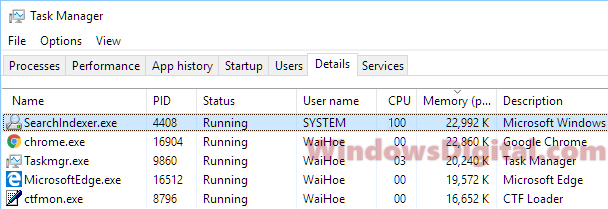
Why is Search Indexer causing high CPU and Disk usage?
When you search for files in the Windows 11 or Windows 10 start menu or File Explorer, you may have noticed the search results can sometimes appear almost instantly. This is because those files have been indexed by a feature called Search Indexer. It is a process that indexes selected files so that searching can be quick. But the indexing process can also cause high CPU and Disk usage in the background. It can sometimes reach as high as 100% (usually when your PC is idle).
The time and resources required to complete the indexing process depend on the number of files it needs to index, the speed of your hard drive (SSD is generally faster), and, of course, the power of your CPU. When the Search Indexer runs at full speed, it might slow down your computer in general.
How to disable Search Indexer in Windows 10/11
We don’t usually suggest turning off Search Indexer, but you can if it’s slowing your computer. Before you decide to turn it off, try the other fixes which we will mention later.
Disabling Search Indexer for a specific disk
To disallow Search Indexer from indexing a particular disk, follow these steps:
- Open File Explorer and go to This PC, where all your drives are listed.
- Right-click on the disk you want to disallow indexing for.
- Select Properties.
- At the bottom of the Properties window, uncheck the box that reads Allow files on this drive to have contents indexed in addition to file properties.
- Click Apply, then OK.
- Restart your computer.
Search Indexer should stop indexing contents on that particular drive. Use this method to stop indexing for drives with a large amount of data that you don’t need indexed.
Completely disabling search indexer
To completely disable the Search Indexer service, follow the steps below:
- Go to the start menu.
- Type services.msc and open it.
- In the Services window, look for Windows Search from the list of services on the right panel.
- Right-click on it and select Properties.
- Beside startup type, click on the drop-down menu and select Disabled.
- Click Apply, then OK.
- Restart your PC.
The Search Indexer service should now be disabled and won’t index any files or contents until you re-enable it. Note that searches for files and contents may take longer now.
Restart Search Indexer (searchindexer.exe) service
Restarting Search Indexer Service
Before completely disabling the Search Indexer service, you should try to restart the service and see if it resolves the high Disk or CPU usage problem.
Sometimes searchindexer.exe can get stuck when indexing files or folders that are too large or are frequently accessed. Restarting the Windows 10 or Windows 11 Search Indexer service can help fix the high Disk/CPU usage issue.
To restart the service, follow these steps:
- Press Windows key + R to open the Run window.
- Type services.msc and hit Enter.
- In the Services window, find Windows Search from the list of services.
- Right-click on it and select Properties.
- Click on the Stop button to stop the service immediately.
- Click on the Start button to restart it.
- Check your Task Manager again to see if Search Indexer is still using high CPU or Disk usage.
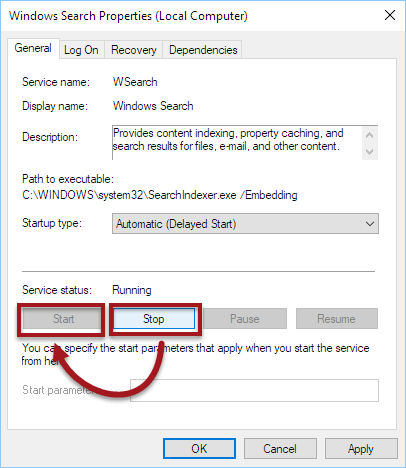
Manually selecting directories to index
When Search Indexer runs non-stop at high Disk/CPU usage, you may want to manually select the directories or folders you want to index. This allows Search Indexer to index only those directories, saving resources by not indexing other large folders you rarely access.
To do this, follow the steps below:
- Go to the start menu.
- Search for indexing, then open Indexing Options from the search results.
- Click on the Modify button.
- Optionally, click on Show all locations before modifying.
- Select or deselect folders or directories you want Search Indexer to index under Change selected locations.
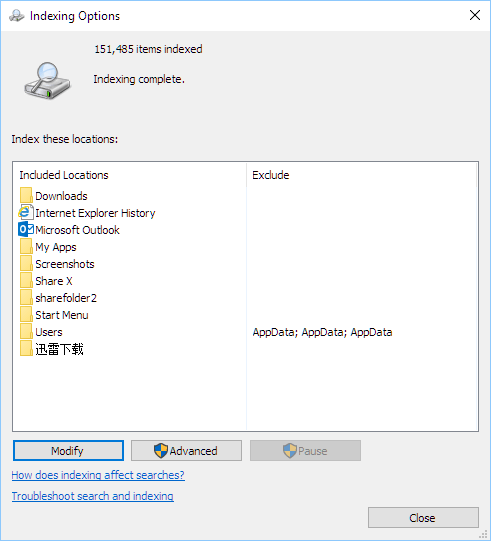
Search Indexer indexes each item only once, and will only index the same item again if changes are made to the file. By selecting only the folders you want it to index, you can immensely reduce the searchindexer.exe high CPU/Disk usage, especially if you have multiple disks with large amounts of data.
Troubleshooting and rebuilding the index to fix high CPU or disk usage
If none of the above solutions work to resolve the Search Indexer high Disk or CPU usage issue, try running the troubleshooter for search and indexing in Windows 10 or Windows 11.
To troubleshoot and rebuild the index, follow the steps below:
- Open Indexing Options as outlined above.
- In the Indexing Options window, click on the Advanced button.
- Under Troubleshooting in the Index Settings tab, click on the troubleshoot search and indexing link.
- The troubleshooter should start to automatically identify and resolve any problems.
If there is an issue with Search Indexer, rebuilding the search index can help resolve it. To rebuild the index, follow these steps:
- Open the Indexing Options window again.
- Click on Advanced.
- Under Troubleshooting, click on the Rebuild button to rebuild the entire search index.
- This may take some time as Search Indexer reindexes your contents.
- After the index is finished, Search Indexer should stop working until new files are added to your disk.
We hope that these solutions can somehow help resolve your Search Indexer high CPU or Disk usage problem in Windows 10 or Windows 11.
Как вы, возможно, знаете, дополнительное накопительное обновление для Windows 10 версии 1903 «Обновление за май 2019», KB4512941 содержит несколько ошибок. Одна из них приводит к ошибкам функции поиска и высокой загрузке ЦП.
Windows 10 1903 build 18362.329 ( KB4512941 ) После установки последнего накопительного обновления многие пользователи начали сообщать о необычно высокой загрузке ЦП, даже когда система простаивает. Высокая загрузка процессора была вызвана процессом SearchUI.exe. Помимо этого, пользователи жалуются на то, что имеются проблемы с Поиском.
Microsoft занималась расследованием проблемы и сообщила обходной путь для устранения проблем.
Чтобы исправить высокую загрузку ЦП в Windows 10 версии 1903,
Шаг 1: Откройте приложение «Параметры».
Шаг 2: Перейдите в «Центр обновления и безопасности» → «Устранение неполадок».
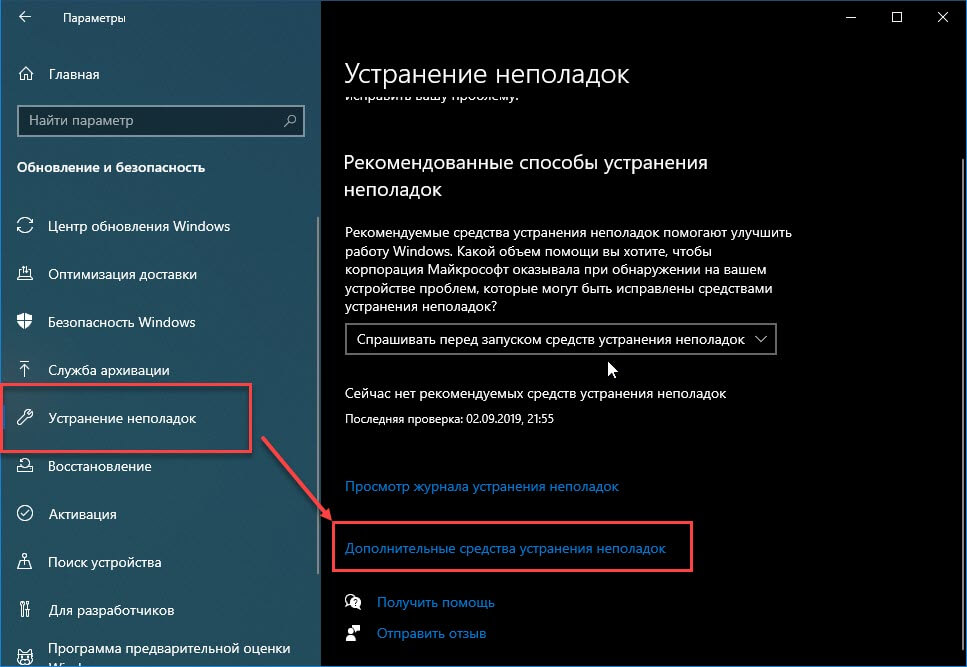
Шаг 3: Нажмите на «Дополнительные средства устранения неполадок».
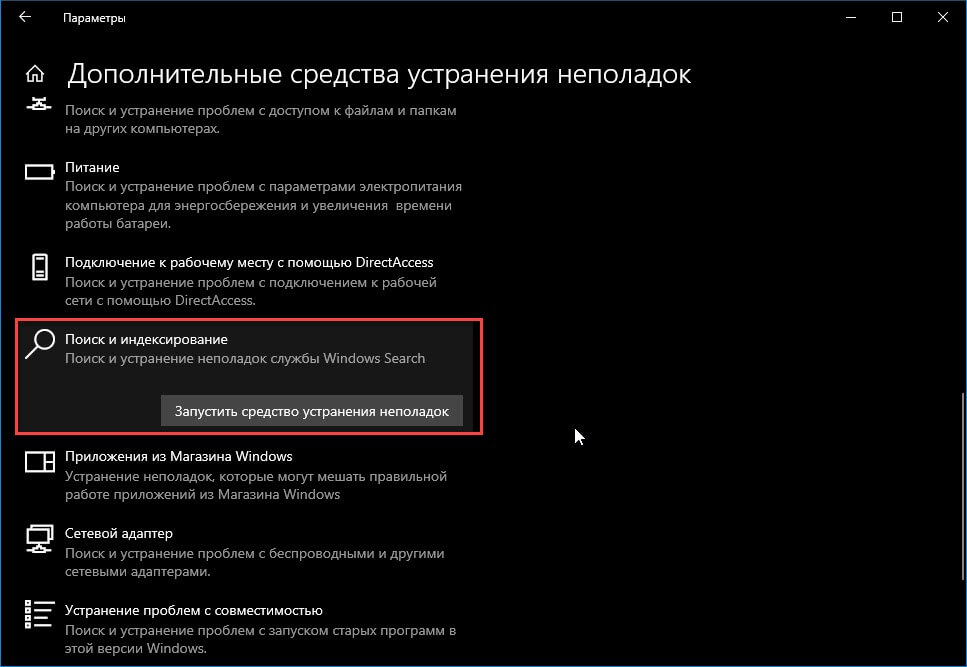
Шаг 4: Нажмите на «Поиск и индексирование».
Шаг 5: Запустите средство устранения неполадок.
Это должно решить проблему автоматически.
Кроме того, вы можете запустить средство устранения неполадок из командной строки.
Запуск устранения неполадок «Поиск и индексирование» из командной строки
Шаг 1: Откройте новую командную строку.
Шаг 2: Введите следующую команду:
msdt.exe -ep WindowsHelp id SearchDiagnostic
Шаг 3: Нажмите клавишу Enter
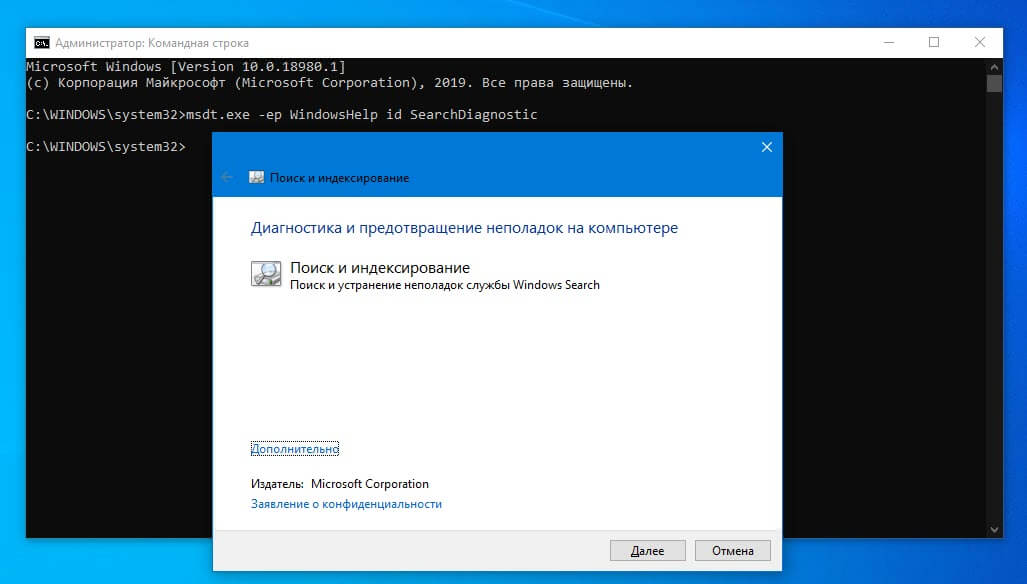
Шаг 4: По окончанию, перезапустите операционную систему .
Также существует сценарий PowerShell, который можно использовать для решения проблемы.
Использование скрипта PowerShell
Шаг 1: Загрузите следующий скрипт PS1.
Шаг 2: Распакуйте его в папку на рабочем столе.
Шаг 3: Кликните правой кнопкой мыши файл, который вы сохранили, и выберите «Выполнить с помощью PowerShell».
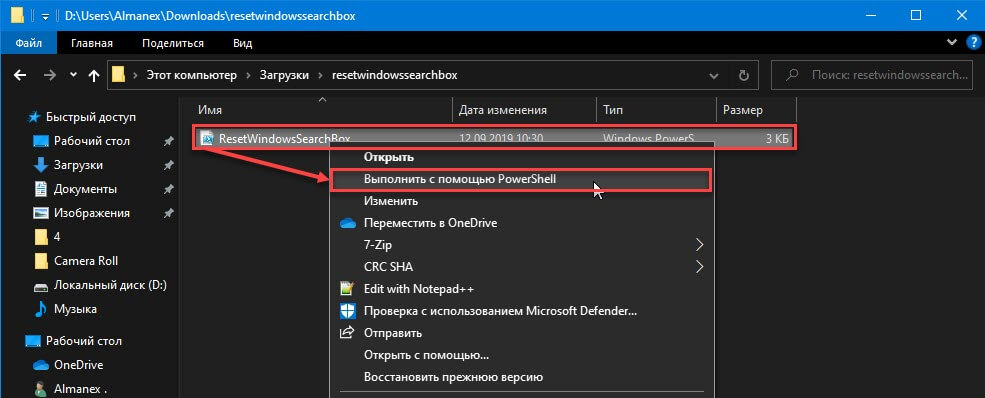
Если вас спросят: «Хотите ли вы, чтобы это приложение могло вносить изменения в ваше устройство?», Выберите «Да». Сценарий PowerShell сбросит функцию поиска Windows.
Примечание: Возможно, вам придется изменить политику выполнения PowerShell на Неограниченная, прежде чем запускать сценарий.
Если приведенные выше решения не помогли решить проблему, необходимо удалить исправление KB4512941.
What is the Microsoft Windows Search Filter Host service on Windows 10/11 or 8.1? It is an executable file developed by Microsoft for the Windows operating system that helps in windows search functions. It is one of the many services activated during the Windows search function.
Whenever a user searches for an item in his computer system with Windows, searchfilterhost.exe builds the index of all the storage drives to speed up the process and quick display of search results.
Sometimes this service may take higher or (100%) CPU usage on your desktop or laptop computer and prevent your other programs from working normally. This guide explains some tips and tricks about SearchFilterHost file/service and how to fix errors/issues related to it.
SearchFilterHost.exe Errors
If you want to locate this service, you can see it as a SearchFilterHost.exe process running in the task manager. This search service consumes some system resources like the CPU. Should we disable this service? Or Is it a Virus? Read along to find the answer to your queries.
SerachFilterHost.exe is a native Windows service, and it should not be disabled since doing so will slow your system down significantly. The other associated files, along with serachfilterhost.exe, that consume system resources are SearchProtocolHost.exe and SearchIndexer.exe.
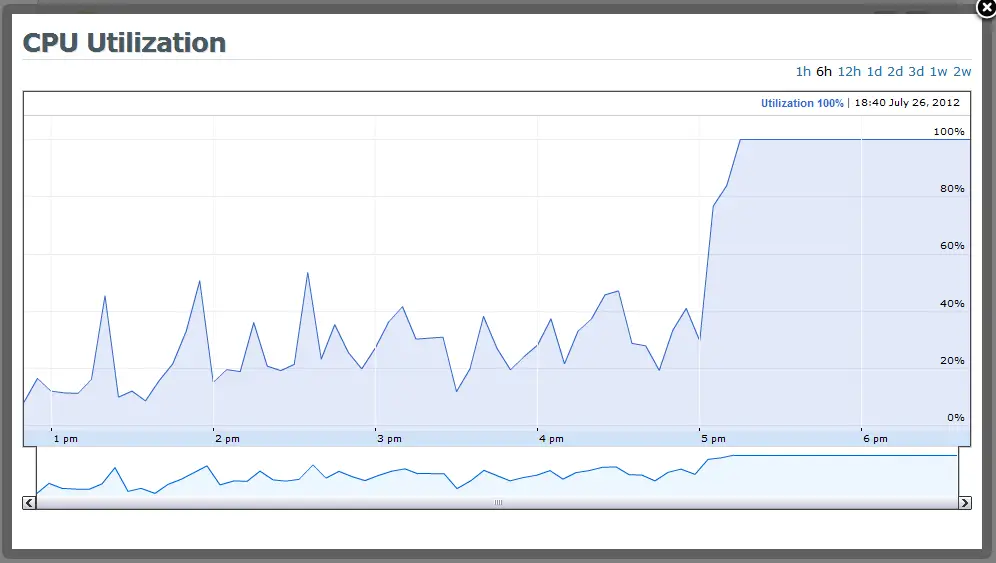
Viruses are generally shipped in as EXE files and are the most common file types prone to get corrupted or replaced by viruses or malware. These infected or virus files are then distributed through emails and spam files, and when these EXE files are executed or run, they corrupt the associated programs and system.
Most of the errors associated with serachfilterhost.exe occur during windows startup or when running a specific program. Some of the common errors include “SearchFilterHost.exe Application Error.”, “Cannot find SearchFilterHost.exe.”, “SearchFilterHost.exe is not a valid Win32 application”, and “SearchFilterHost.exe is not running.
Causes of Search Filter Host Errors on Windows
The serachfilterhost problems can primarily arise due to virus or malware infection. Other reasons that contribute to these errors are
- Corruption of search filter host files, Windows OS files or applications by the virus.
- Incomplete installation of the Windows operating system
- Windows Registry Keys associated with Windows OS or serachfilterhost.exe have been corrupted.
- Another application is conflicting with the Windows operating system
Related: What is the utweb.exe service in Windows 11?
Steps to Troubleshoot Microsoft Windows Search Filter Host Errors
Any problem occurring in the serachfilterhost.exe file can lead to an unprecedented increase in the use of the CPU. Depending on the gravity and the cause of the problem, there are many ways to address this issue. There is no specific solution to this issue, but you can try the following methods to fix the issues related to it or higher CPU usage on Windows 10 or 8.1.
1. Rebuild Index
Since the search filter is related to the indexing files, you can resolve the issue by opening the control panel and looking for indexing options. Click on “Advanced”. In the next window, under the troubleshooting section, click “rebuild”, which will delete the old indexing and re-build the indexing afresh.
2. Modify Index
You can modify the way indexing is performed in the Windows operating system. You have the option to add or delete the files from the indexing list. One file extension that takes up high resources is XML extension files. Follow the procedure below to modify the indexing settings.
Open Control Panel> Indexing options>Modify
You can click “show all locations” if all the drives are not visible in the window. In the window showing all the locations, you can select or unselect the drives, folders, subfolders or files.
3. Repair Registry Entries
As already mentioned, one of the causes of searchfilterhost.exe errors is errors in their Windows Registry entries. Many programs in a system can share the same searchfilterhost.exe file. So deleting one or more programs from the PC can leave invalid or orphan entries in the Windows Registry. Thus it is important to repair these entries to resolve the issues arising from searchfilterhost.exe errors.
There are two methods to repair the Windows Registry. You can do it either manually or use a third-party repair tool. If you intend to do it manually (which is not recommended), even minor careless editing of the registry file can render the Windows operating system unstable. So it should be done only by a Microsoft-certified professional.
Whichever way you want to repair Registry Key, you should always take a backup of searchfilterhost.exe registry keys by following these steps.
Press win+R and Type Regedit in the RUN window; it will open the registry editor. The next step is to find the SearchFilterHost.exe-related key and select Export to save the Registry Key in the specified location.
Many 3rd party tools and software are available online to repair errors related to Windows Registry keys. Most of these tools are capable of taking automatic backup of registry keys. These registry cleaner tools find invalid registry entries, broken links within the registry and
missing file references and repairs them, enhancing the Windows OS speed and overall PC performance.
4. Malware Scan
The searchfilterhost.exe errors can be the result of virus infection on the PC. The intruded malware can replace, delete or corrupt the searchfilterhost.exe or related files. The best way to eliminate malware or virus is to scan the full PC with effective anti-malware software.
5. Windows Update
Microsoft is constantly releasing its updates to counter the discrepancies in earlier releases and improve the Windows system files. Most errors are automatically removed after updating Windows with its latest patch.
You can type Windows Update in the search field and click the “check for updates” button to update Windows.
6. Run in-built Windows file checker
Windows operating system has an inbuilt utility, “System File Checker”, that can scan and repair corrupt system files.
To run the utility, you need to open a command prompt. Open start> Win+R> type cmd> type “sfc /scannow” and finally press ENTER.
7. Re-install Windows
If the searchfilterhost.exe is still deteriorating the system’s performance by hogging CPU resources, the final option is to reinstall Windows 10 or 11 Operating System afresh.
“Note: Do not forget to take the backup of important files before installing a fresh copy of Windows OS.”
Is SearchFilterHost a virus?
SearchFilterHost.exe is not a virus but a native service of the Windows Operating System by Microsoft. It supports the Windows search functionality of your computer. Disabling or stopping the service will interrupt your PC’s search index feature.
How do I disable the Microsoft Search filter host?
You can disable the ‘Windows search’ service to accomplish this. Under the ‘Services’ console in Windows 11/10, locate the ‘Windows Search’ service. Stop the service first, then change the startup type to ‘Disabled’.
The searchfilterhost.exe file is necessary for the search function to work properly. The corrupted file can occupy some resources, but the search filter host service should not be disabled. We hope this guide will be useful in understanding and fixing any issues related to this Windows service.

